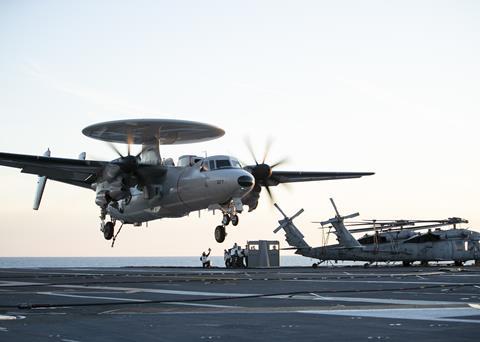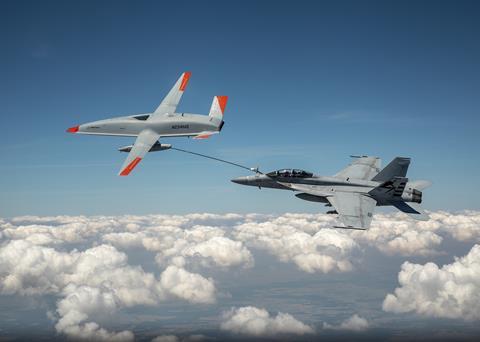A Northrop Grumman E-2D Advanced Hawkeye airborne command and control aircraft was shown to be able to control a Boeing MQ-25A Stingray unmanned in-flight aerial refuelling tanker in a simulation.
The simulation was intended to show possible US Navy (USN) carrier air wing concepts for the unmanned tanker and demonstrate a potential new use for the E-2D.

The virtual demonstration was sponsored by the Office of Naval Research. It used Northrop’s portable E-2D simulator with virtual representations of Boeing’s F/A-18E/F and MQ-25A to show that the command-and-control aircraft could control the unmanned air vehicle (UAV) using existing flight program software, Boeing said on 3 August.
As part of simulated missions, the E-2D acted as a “tanker king” while the MQ-25 refuelled the F/A-18E/F, says Boeing. The E-2D also supervised the MQ-25A during an intelligence, surveillance and reconnaissance (ISR) mission in the virtual exercise.
“Two of our key findings from this early demonstration with existing data links are that initial [manned-unmanned teaming] capability between MQ-25, E-2D and F/A-18 is achievable with minimal change to the crew vehicle interface and could be integrated into earlier MQ-25 operational deployments,” says Don Gaddis, Boeing’s MQ-25 programme director.
The E-2D should be able to control the tanker’s orbit station, flight path and aerial refuelling store payload, says the company. With minimal changes to its cockpit display, the F/A-18E/F also ought to be able to control the UAV.
Boeing says that the mission simulations also demonstrated using an “open behavioural software framework” to create UAV commands.
“As a result, pilots can call a play for the unmanned system, much like a coach,” Gaddis says. “This play call ability greatly simplifies the supervising pilot’s workload and minimises the data link exchanges required. It’s all part of building platform-agnostic, portable and reusable [manned-unmanned teaming] software.”

The USN plans to initially control the MQ-25 via a station on its aircraft carriers. However, FlightGlobal reported in March the service awarded Northrop a sole-source contract to modify the E-2D mission computer and display software so that the aircraft could control UAVs.
The unmanned MQ-25A tanker is intended to extend the reach of the Lockheed Martin F-35C, which has an unrefuelled range of about 1,200nm (2,200km) – not long enough to keep US aircraft carriers outside of the striking distance of China’s land-based ballistic and cruise missiles.
The USN plans to also examine using the MQ-25A for ISR, electronic attack and strike missions after it figures out how to use the UAV for in-flight refuelling and how to handle the unmanned aircraft on a carrier deck.
In June, the USN demonstrated for the first time the MQ-25A refuelling an F/A-18F in an actual flight. That flight test used a ground station to control the UAV.
The MQ-25A is still in the developmental and testing phase. The USN has said it wants the UAV to achieve initial operational capability by 2024. It plans to buy as many as 76 examples of the aircraft as part of its programme of record.


































